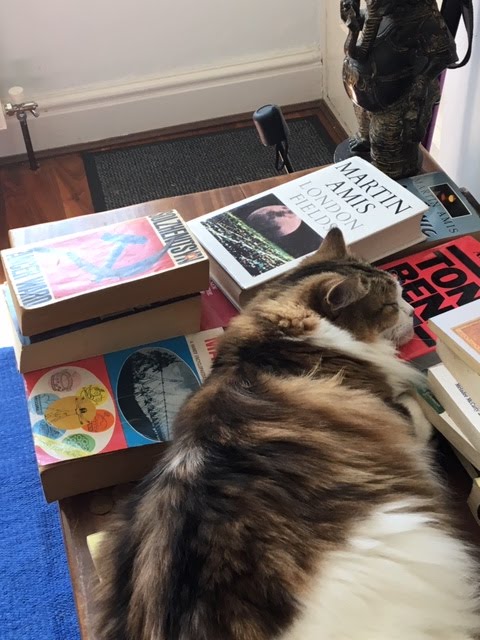I have never seen a steam-iron like this monster. It spews steam and venom, hisses like an inconvenienced cat, and breathes fire every half-minute as it gathers itself for another attack on my tender susceptibilities.
And it is BIG! The size of a small dog almost. We shall need an extra room to store it. I'm scared of it and when my daughter is ironing, I keep a safe distance. I keep a safe distance from ironing anyway, due to congenital laziness. I was not born to this.
In our house in Thalassery, when I was a little girl, we had no iron at all. Devi, the maid, dumped our washed clothes on a vacant bench in Achamma's room and we children just pulled out a school-dress as we heard the sound of the jutka (horse-drawn carriage) trotting up to our house. If we were late, the Jutka-man would simply give the mare a little encouragement on its haunches with the whip, and she would rear up and gallop off.
The clothes smelled of the rice-starch Devi used on the dresses and when she was really enthusiastic, the dresses could probably stand up on their own.
Somewhere along the line, we acquired an old iron, much abused. From the junk-room, I think, and there was a good reason it was there. The lid of the iron did not hold and it had a habit of dropping the smouldering charcoal on pristine mundus. The maid generally put a piece of cane on the bolt on the lid to prevent coal escaping, but the stick sometimes let you down, sliding off, breaking up... We, children, were not allowed to go near it for obvious reasons.
As we got older and began noticing the well-turned-out girls in school, who actually had mothers and such like (mine had been dead a long time) my cousin Mani and I conspired to get our hands on the treacherous iron. BUT - the iron needed charcoal, generally made from coconut shells. The coconuts had to be really dry before the shells could light up; so we would have to wait till the kitchen used a properly dry coconut. This could take weeks.
Getting the iron ready was quite a process. First you set the coconut shell on fire till it blazed. In about five minutes the flame would die down leaving bright red charcoal. Then the charcoal could go straight into the innards of the iron. It would stay hot enough to iron for about half an hour; after that it would need a complicated refill. Mani and I gave up and settled for unironed clothes.
These days I sit back and watch the iron glide on clothes. which will be worn for a few months and after, donated to charities. I remember the time when I had two dresses for school and just getting them dry for wear in the monsoon season was a house-hold challenge.
And it is BIG! The size of a small dog almost. We shall need an extra room to store it. I'm scared of it and when my daughter is ironing, I keep a safe distance. I keep a safe distance from ironing anyway, due to congenital laziness. I was not born to this.
In our house in Thalassery, when I was a little girl, we had no iron at all. Devi, the maid, dumped our washed clothes on a vacant bench in Achamma's room and we children just pulled out a school-dress as we heard the sound of the jutka (horse-drawn carriage) trotting up to our house. If we were late, the Jutka-man would simply give the mare a little encouragement on its haunches with the whip, and she would rear up and gallop off.
The clothes smelled of the rice-starch Devi used on the dresses and when she was really enthusiastic, the dresses could probably stand up on their own.
Somewhere along the line, we acquired an old iron, much abused. From the junk-room, I think, and there was a good reason it was there. The lid of the iron did not hold and it had a habit of dropping the smouldering charcoal on pristine mundus. The maid generally put a piece of cane on the bolt on the lid to prevent coal escaping, but the stick sometimes let you down, sliding off, breaking up... We, children, were not allowed to go near it for obvious reasons.
As we got older and began noticing the well-turned-out girls in school, who actually had mothers and such like (mine had been dead a long time) my cousin Mani and I conspired to get our hands on the treacherous iron. BUT - the iron needed charcoal, generally made from coconut shells. The coconuts had to be really dry before the shells could light up; so we would have to wait till the kitchen used a properly dry coconut. This could take weeks.
Getting the iron ready was quite a process. First you set the coconut shell on fire till it blazed. In about five minutes the flame would die down leaving bright red charcoal. Then the charcoal could go straight into the innards of the iron. It would stay hot enough to iron for about half an hour; after that it would need a complicated refill. Mani and I gave up and settled for unironed clothes.
These days I sit back and watch the iron glide on clothes. which will be worn for a few months and after, donated to charities. I remember the time when I had two dresses for school and just getting them dry for wear in the monsoon season was a house-hold challenge.

No comments:
Post a Comment